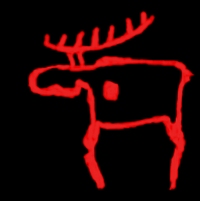
Ilmarinen, a blacksmith and inventor in the Kalevala, is a god and archetypal artificer from Finnish mythology. He is immortal and capable of creating practically anything, but is portrayed as being unlucky in love. He is described as working the known metals of the time, including brass, copper, iron, gold, and silver. The great works of Ilmarinen include the crafting of the dome of the sky and the forging of the Sampo. His usual epithet in the Kalevala is seppä or seppo ("smith"), which is the source of the given name Seppo.

Traditional Sámi spiritual practices and beliefs are based on a type of animism, polytheism, and what anthropologists may consider shamanism. The religious traditions can vary considerably from region to region within Sápmi.

The Fenni were an ancient people of northeastern Europe, first described by Cornelius Tacitus in Germania in AD 98.

Chud or Chude is a term historically applied in the early East Slavic annals to several Finnic peoples in the area of what is now Estonia, Karelia and Northwestern Russia.

Finnic paganism is the indigenous pagan religion in Finland, Karelia, Ingria and Estonia prior to Christianisation. It was a polytheistic religion, worshipping a number of different deities. The principal god was the god of thunder and the sky, Ukko; other important gods included Jumo (Jumala), Ahti, and Tapio. Jumala was a sky god; today, the word "Jumala" refers to all gods in general. Ahti was a god of the sea, waters and fish. Tapio was the god of forests and hunting.
The Finnic (Fennic) or more precisely Balto-Finniclanguages constitute a branch of the Uralic language family spoken around the Baltic Sea by the Baltic Finnic peoples. There are around 7 million speakers, who live mainly in Finland and Estonia.
Baltic mythology is the body of mythology of the Baltic people stemming from Baltic paganism and continuing after Christianization and into Baltic folklore.
Elements of a Proto-Uralic religion can be recovered from reconstructions of the Proto-Uralic language.

The Baltic Finnic or Balto-Finnic peoples, also referred to as the Baltic Sea Finns, Baltic Finns, sometimes Western Finnic and often simply as the Finnic peoples, are the peoples inhabiting the Baltic Sea region in Northern and Eastern Europe who speak Finnic languages. They include the Finns, Estonians, Karelians, Veps, Izhorians, Votes, and Livonians. In some cases the Kvens, Ingrians, Tornedalians and speakers of Meänkieli are considered separate from the Finns.

Sámi languages, in English also rendered as Sami and Saami, are a group of Uralic languages spoken by the Sámi people in Northern Europe. There are, depending on the nature and terms of division, ten or more Sami languages. Several spellings have been used for the Sámi languages, including Sámi, Sami, Saami, Saame, Sámic, Samic and Saamic, as well as the exonyms Lappish and Lappic. The last two, along with the term Lapp, are now often considered pejorative.
Raedieahkka or Radien-akka is a goddess in the Sami mythology. She is the wife of the Sami high god Radien-attje, and the mother of Rana Niejta and Raediengiedte.
Tjaetsieålmaj or Thjathjeolmai controlled lakes and rivers, and gave fishing fortune to people in Sami mythology. The word Thjathje means water, and is said to be the origin of the name of the Norse jötunn Tjatsi.
Radien-pardne or Raediengiedte is a Sami god, the son of Radien-attje and Raedieahkka in Sami mythology.
Ipmil or Ipmilbalolaš means God in the Northern Sami language.
Proto-Sámi is the hypothetical, reconstructed common ancestor of the Sámi languages. It is a descendant of the Proto-Uralic language.

Tietäjä is a magically powerful figure in traditional Finno-Karelian culture, whose supernatural powers arise from his great knowledge.
Uralic neopaganism encompasses contemporary movements which have been reviving or revitalising the ethnic religions of the various peoples who speak Uralic languages. The movement has taken place since the 1980s and 1990s, after the collapse of the Soviet Union and alongside the ethnonational and cultural reawakening of the Finnic peoples of Russia, the Estonians and the Finns. In fact, Neopagan movements in Finland and Estonia have much older roots, dating from the early 20th century.
This is an index to deities of the different religions, cultures and mythologies of the world, listed by region or culture.







